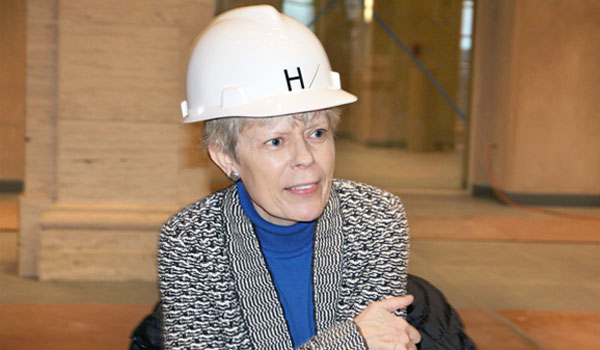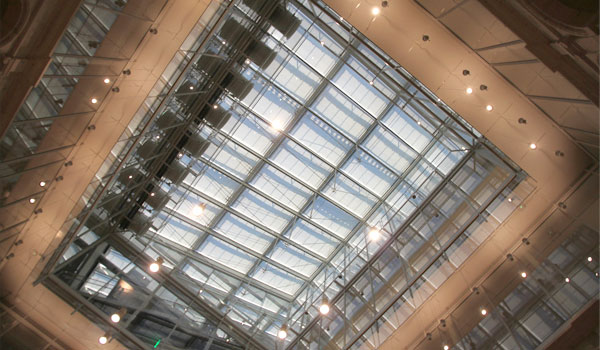As we look forward to the opening of the new Harvard Art Museums on November 16, art historian Kathryn Brush took a moment to look back at the Fogg Museum’s history as a pioneer in the international development of art research and teaching.
Brush, who is professor of art history at the University of Western Ontario, Canada, should know, having spent endless hours in the Harvard Art Museums Archives to write her 2004 book, Vastly More than Brick and Mortar: Reinventing the Fogg Art Museum in the 1920s. The text details the formative years of the Fogg, when it became the first museum in the United States designed for the specialized training of art scholars and museum professionals.
During a recent tour of the building site, Brush pointed out how the two new entrances create a “throughway” to the renovated courtyard, bringing visitors from multiple areas and entrances into a central space that forms the nucleus of the building. That architectural model, she said, echoes the “tightly knit conversation” among exhibition, teaching, and public spaces that raised the profile of the Fogg in the 20th century.
When the Fogg opened its 32 Quincy Street location in 1927, it “brought together art conservation, museum study, and written research on works of art,” allowing students to attend lectures, develop exhibitions to practice their curatorial skills, and even study the chemical makeup of paintings in museum labs. At the time, the Fogg Museum, with its rapidly growing collection of objects from diverse cultures and historical eras, “was unique in the United States” as an art training facility.
Standing in the new courtyard, Brush said that legacy would not only continue but expand for students and scholars once the new facility opens. “You’ll have the Straus Center for Conservation and Technical Studies, classrooms, galleries, rotating exhibitions—it’s really an updated version of what was happening in 1927, when the building first opened.”
Building the Fogg Museum in the 1920s was an ambitious, forward-looking project, Brush said, because it helped launch formalized art study in the United States. In 1909, Edward Forbes became the new director of the “then very insignificant” Fogg Museum, which at that time had “plaster casts and a few original paintings” in its collection. In 1915, however, Forbes convinced Paul J. Sachs (of Goldman Sachs) to be the museum’s associate director. The alliance spurred philanthropy from Wall Street to the Fogg, forming a key turning point for the museum and its collection.
Sachs went on to train most of the museum directors and curators in the United States through the 1940s. Brush describes his influence as “extraordinary,” because so many of his students went on to direct “many of the growing and newly established museums in the United States.”
Forbes, on the other hand, was intently focused on the technical study of art—an equally important branch of study, as works of art were “flooding into the US,” Brush said. The arrival of paintings, drawings, sculptures, and works in other media on American shores demanded the creation of professionalized knowledge about how to care for and preserve such objects. Forbes started the Department of Technical Studies in 1928, the first fine arts conservation, research, and training facility established in the United States, now the Straus Center for Conservation and Technical Studies. Even earlier in the decade he had begun to encourage students to engage actively with artistic materials, including the making of pigments and the replication of techniques of the masters, in order to better understand how to preserve a work of art.
For Brush, the Fogg Museum of 1927 was a place that students could “work with original works of art, hear lectures about art history, consult photograph collections, study the makeup of pigments, and even conduct X-ray work on paintings”—concepts that were very much in the vanguard at the time.
“The Fogg Museum made an important statement about Harvard’s investment in art research and education at a very early point,” Brush said. “There was no other academic art museum in the United States that could rival it, and there were few parallels in Europe . . . The Fogg was always meant to be a great teaching museum. And now this great and imaginative revitalization project will continue that mission along with the Busch-Reisinger and Arthur M. Sackler museums, but in a 21st-century context, and with 21st-century equipment.”





